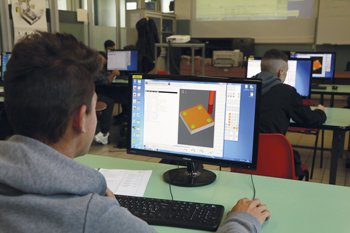An Integrated Model for School/Work Place Training
The dual system, announced by the Italian government in 2015, is a model of integrated partnership between schools and the workplace, which has already been used with success by countries in Northern Europe. The system’s goal is to create an ongoing relationship between education and the workplace, promoting constructive dialogue.
di Alberto Marelli
The need to combat youth unemployment and rein in those abandoning school by creating a bridge connecting education with the workplace was what led the Italian government to set up the “dual system” in 2015: integrating school and the world of work as happens in Germany and other North European countries.
“When we speak about dual training – explains Francesco Cristinelli, Director of the professional training centre CNOS-FAP in Sesto San Giovanni near Milan – it is usually in reference to the school-work experience system which sees schools working hand in hand with companies in training students”. Differently from previous work experience programs, the dual system promotes a continuative and organic relationship across the contexts, two bodies who, until today, have rarely been in contact: education, professional training and the workplace. Two pieces of Italian legislation, the Jobs act and Buona Scuola (a good education system) have been set up, in part, to completely review the apprenticeship system and to render work experience a structural element of all students’ high school years. “The dual system is not to be seen as a single solution but as a general school workplace transitional approach. The goal will be to allow young people still attending school to get to know the job market better, to gain useful experience and to cut the time gap between school and professional experience”, confirms Cristinelli.
The dual system in three ways
Upon finishing the first two years of high school, Italian students can decide whether to go ahead for a further three years (in secondary school, technical institute or professional school) or in the IeFP professional training system. This is a regional operation and gives a certificate for either three or four year attendance.
The IeFP pathway can be followed in one of the recognized regional training centers or, where possible, in a state run professional school. To gain access to university or to technical high school, students in possession of an IeFP diploma can take a year long course leading to the professional high school certificate.
For students choosing the IeFP, the dual system offers three options: school-work experience (990 hours of annual training, 50% spent in company); a simulated training company where didactic training specific to the company in question will be carried out creating an overall programme known as “apprenticeship”.
The apprenticeship contract becomes the most fluid way to bring young people into the working context. The apprentice contract will become, under this format, the most utilized structure for young people’s entrance into the workplace. On one side, it guarantees an officially recognized study certificate and on the other, direct professional experience.
Apprenticeship training
The 2015 reform created three levels of apprenticeship. At the first level, the employer pays the apprentice and provides training but enjoys a series of fiscal benefits both for temporary and permanent contracts. Qualifications required are completion of 2nd year of high school and a high school technical certificate. Those between 15 and 25 qualify for this type of contract and it is perfect for anyone wishing to continue their studies while also gaining key professional experience. The second level follows the pathway to a professional qualification. Ages range from 18 to 29 as well as those in subsidized unemployment without age limit. The third level regards specialized training and research leading to a university level qualification. Young people between the ages of 18 and 29 will be hired, leading to a specialized professional career. They will become members of the workforce helping companies to innovate and expand thanks to the interface between the academic institution and the employer.
Apprenticeship, level one
The typically small sized Italian mechanical firm will be especially interested in the 1st level qualification and professional certificate. “We get many requests from students in years three and four of high school that we can’t completely satisfy. In Lombardy, we have 51 apprentices in the industrial mechanical sector with 15 in molding companies.” underlines Cristinelli. The minimum duration of level one is 6 months and up to 1 year, when the diploma is taken. This type of relationship is popular with companies because the student is trained ad-hoc. A tutor must follow the apprentice to ensure internal and external training is complete together with correct integration into the company. Maurizio Todeschini, National mechanical sector secretary at CNOS-FAP observes “The traditional idea has been turned on its head. Internal training is done in company and external in school. Both the school and the company will be responsible for putting together, monitoring and checking the progress of this “Dual approach”. The CNOS-FAP apprenticeship foresees 1600 hours of training, split into 400 training hours externally at the professional training centre, 590 training hours in company and 610 working in company. “Companies have been seen to welcome the role of training the student, helping them to overcome any initial difficulties faced” explains Cristinelli. At the end of the apprenticeship, the company can decide whether to continue the relationship or terminate the contract. “Since the dual system was introduced, around 60-70% of our students working as apprentices have remained in the company. Clear proof of the success of the project”, Cristinelli concludes.

